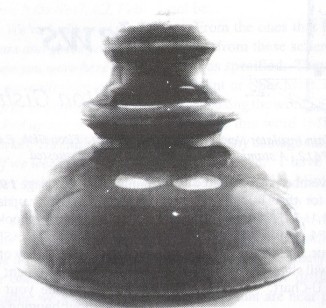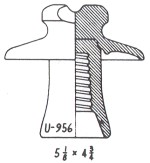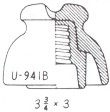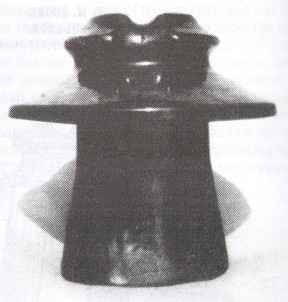Porcelain Insulator News
by Elton Gish
Reprinted from "Crown Jewels of the Wire", March 1993, page 5
Last November, we presented six new styles for the U-Chart: U-196 (Fred
Locke) , U-706A ("CENTRAL"), U-972, U-984, U-987, and U-989. The last
four are threadless. This month, we will show five more additions to the
U-Chart.
For those of you that may not be familiar with the U-Chart, this is the
numbering system for unipart porcelain insulators, which was developed by Jack
Tod in 1971. Jack's 3rd edition book, Porcelain Insulators Guide Book was
published in 1988 (see ad in back of this issue for ordering information). Since
that time, 29 new unipart styles have been reported, which make a total of 1022
styles. Actually, there are 3-4 more than that now, which we will talk about in
a future issue. Last Fall, I published a four-page 1992 U-Chart
Supplement, which updates the style
drawings for Jack's book. If you will send me a legal size SASE and $1.00, I
will send you a copy of the supplement. The supplement will conveniently fit
inside your 3rd edition book, without hanging out, where it will always be easy
to find.
Many of you know Bill Rohde and his fantastic porcelain collection,
most notably his multipart collection. A couple of years ago, Bill reported a
very unusual porcelain insulator, which we have been very late in reporting.
This new unipart style has been assigned U-372. I had a difficult time trying to
decide where to put it in the U-Chart, since it was not like anything else ever
reported. As you can see, the shape of this insulator is very close to the glass
CD 282 Hemingray No.2 Provo and the CD 283 Hemingray No.1 Provo. The CD number
drawings are shown courtesy of N. R. Woodward, as shown in his book, The Glass Insulator in America -1988 Report (see "Reference
Library" page under Albers for ordering information.)


Unmarked Pittsburg U-372
It is not surprising to learn that Pittsburg made U-372. Pittsburg was famous
for making very odd styles, in an apparent effort to capture business, no matter
how small the order. Odd shapes were their specialty, which could easily be made
in 2-part molds. Many of their simpler shapes were also made in 2-part molds,
which eliminated the need for a trimmer operator to cut the wire groove.
However, the use of 2-part molds produced a quality problem, which did not seem
to concern Pittsburg. If you are familiar with Pittsburg unipart insulators, you
undoubtedly recognized that quality was of little concern to them. Multipart
insulators seem to be the exception. since high voltage has no mercy for cheap, poorly made insulators. Perhaps, if they
had been more concerned with the quality of their unipart insulators, Pittsburg
would have lasted longer in the business, but they would not have made near the
number of insulators during the eleven years that they were in business.
When
the clay is pressed in a 2-part mold, with great pressure, some of the clay
squirts through the two mold halves. The resultant mold line equally splits the
shape of the insulator. Where the clay was squeezed out along this mold line,
the long, microscopic, clay particles align them. selves with the mold line.
This makes the insulator susceptible to fracturing along the mold line. Some Pittsburg specimens, with pronounced mold lines
over the top, can easily be split in half with a blow to the top of the crown. I
have seen some specimens that even had a small crack somewhere along the mold
line, which developed when the insulator was made.
Pittsburg evidently had an
obsession about not wanting to lose a sale for lack of a design that the
customer wanted. Even though they made many more styles than their catalogs
showed, their catalogs still contained a plethora of styles. For example, their
1918 catalog lists no less than nine "hat-shaped" double petticoat styles, some of which
differed from others, only because of a slightly different crown radius. Also,
they listed six different pony or semi-toll styles. While other companies
cataloged only the more popular styles of each voltage class, Pittsburg went out
of their way to make special designs for their customers. They essentially
operated a "short order business" for insulator customers.
This next
Pittsburg style is another example of them copying popular glass styles. Fred
Collier has kindly loaned me his undated Pittsburg catalog No.2. This could very well be the only Pittsburg catalog that has survived. I would guess that
it was published circa 1912. As you can see from the full-page reproduced here,
the insulator is a porcelain copy of the Barclay insulator, which is identical
to the glass CD 147. A specimen of this insulator has never been found, but I am
reserving the style number, U-147, if it does appear. Surely, if one of you had
found a specimen of this style, then it would have been reported. But then, the
"Provo" U-372 was rather unique, too, and it was not reported until
recently. Keep looking!!
 |
 |
|
Unmarked U-956 |
James Colburn reported an early, classic two-part,
glazeweld, which we have assigned U-956. Due to its small size, this insulator looks
quite common when it is mixed in with other insulators on a sales table, That is
why James decided to place it under a glass dome at the Orlando National. And,
yes, it did attract a lot of attention. This unmarked insulator appears well
made. I would guess that it was made by Thomas before 1910; however, I would not
rule out New Lexington. It does not have any characteristics that would allow a
good guess, other than the fact that only Locke and Thomas used the
glaze-welding technique, with the exception of a few styles made by Pittsburg,
and at least one style made by New Lexington (U-966A).

The next three new styles are Fred Locke insulators. The first one is the
two-part, glaze-weld style, U-941B. Three of these have been reported. They are
all white with the Fred Locke under-glaze ink marking #6-3. Based on the last
patent date in the marking, June 7,1898, these insulators were made after that
date, and before Fred's next patent, dated May 29, 1900. Robin Harrison reported
the third specimen. The first report of this glaze-weld insulator was made by me
in the January, 1985 issue of Crown Jewels of the Wire. At that time, we called
it a U-610A, but it really needed a new U-number, since it is a glaze-weld, and an
early classic. U-941B is the predecessor to the Fred Locke U-610A and other
similar cable-top styles.
 |
 |
|
U-941B with Fred Locke under-glaze ink marking #6-3 |
As will be discussed in my upcoming book, which will be a biography of Fred
Locke (maybe available later this year), the under-glaze ink marked Fred Locke
specimens were not made by Fred. We now know which company made these glazeweld
specimens for him, and it was not Imperial! The name of that company will be
revealed in the book, along with a detailed history of Fred' s family, how he
started jobbing electrical supplies in 1892, his short-lived partnership to sell
his patented pins and glass insulators, his jobber business selling porcelain
insulators (made by three different companies), why he sold the Victor factory,
and much more. So much new information has been uncovered recently, that it has
caused the entire history of Fred Locke to be rewritten.
The second new Fred Locke style is U-969. This
insulator was reported incorrectly as M-2335, in the September, 1990 issue of
Crown Jewels of the Wire. I recently saw this one-of-a-kind insulator. I was
amazed that it was actually a two-part, glazeweld, rather than two parts
cemented together, and it had only one spout, instead of two! It has a crackled,
dull white glaze, and marking #6-2. As with M-2335 (2-spouts) and M-2795 (1-spout), U-969 has a raised ridge, or eave trough, around the outside edge
of the top skirt, and one spout. This design was to allow the rain to collect on
top, and drop to the side of the crossarm from the spout, instead of splashing
on the crossarm, wetting the underside of the insulator. This design proved to
be of no benefit. Dirt would collect on top of the broad top skirt, contributing
to surface leakage during wet weather.
 |
 |
|
U-969 with Fred Locke
marking #6-2 |
The third new Fred Locke is U-957A. The glaze on this only known specimen is
very dark tan. There is a weak # 7-1 marking on the top skirt. This insulator is
a cousin to U-957, and has a skirt that is more than one inch longer. This
long-skirt style was made to conform to Fred's patent No. 852,730, granted on
May 7, 1907 (patent application filed on November 16, 1903). The patent claimed
the long, slightly flared skirt, which would maintain a uniform distance from the pin, and ultimately rest on the crossarm. Even in rainy weather,
this design was claimed to provide a dry area inside the bottom skirt and around
the pin. By keeping the pin and inner surface of the insulator dry, it was
claimed that the chance of electrical leakage to the pin, during wet weather,
would be greatly reduced. It is unfortunate that the single specimens of U-969
and U-957A probably will never find their way into collector's hands.

Medium Image (74 Kb)
Large Image (169 Kb)
 |
 |
| U-957A with Fred Locke marking #7-1 |
|
